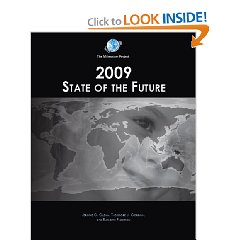
Jerome Glenn, Theodore Gordon, and Elizabeth Florescu
This book, which includes a CD with a ton of additional information and visualization, is worth every penny of the asking price. It brings together global statistics, illustrations, and expert depictions of alternative scenarios.
Although it focuses primarily on Energy & Economies, it is closely tied in with achieving all of the Millenium Goals set by the Member Nations of the United Nations, and cacn easily be scaled up and out as more resources are applied.
I get this book as a core reference, along with Lester Brown's State of the World 2009: Into a Warming World (State of the World). When combined with High Noon 20 Global Problems, 20 Years to Solve Them and the UN High Level Threat Panel report (also free online), A More Secure World: Our Shared Responsibility–Report of the Secretary-General's High-level Panel on Threats, Challenges and Change one has an instant core library for the bottom line: the future of life on Earth.
The book is actually in two pieces. 129 black and white pages that is comprised of an Executive Summary, a section on Global Challenges, a State of the Future Index, 40 pages on four global energy scenarios, a separate chapter on emerging environmental security issues (see my review of Max Manwaring's “Environmental Security and Global Stability”), and a final chapter on reflections as the project achieves its tenth anniversary.
The printed book also includes a table of contents for the CD-ROM of 5,400 pages with color graphics and global maps that are quite good, and the publishers are to be complemented for providing the CD material in both PDF form and Document form, the latter for ease of extraction of pictures and text for repurposing.
The day will come when this book and the CD are available in a Serious Game that is both receiving near-real-time information feeds from all open sources in all languages, AND is connected to the real-world budgets of all governments and non-governmental organizations and private sector parties so that any individual can type in their zip code and their issue, and see the color-coded “threat condition” corresponding to whether or not their level of government or their organization is spending wisely, what I call “reality-based budgeting.”
The authors have done a superb job of documenting reality, and as I went through the book, I could not help but feel that we need a second book that evaluated national-level budgets in detail, to publicize the erroneous trade-offs that are being made without the public's real understanding or approval–too much money for a heavy-metal military and corporate tax loopholes, not enough for a global educational Marshall Plan and free telecommunications for the five billion poor (easily affordable for the half trillion the USA has wasted on the elective invasion and sustained heavy-handed occupation of Iraq).
In brief, this book, the CD, this project, are a *cornerstone* for building our future. Worth every penny, and worth several hours of a good read and reflection.
See also:
Collective Intelligence: Creating a Prosperous World at Peace
The Future of Life
Philosphy and the Social Problem
The Landscape of History: How Historians Map the Past
The New Craft of Intelligence: Personal, Public, & Political–Citizen's Action Handbook for Fighting Terrorism, Genocide, Disease, Toxic Bombs, & Corruption
THE SMART NATION ACT: Public Intelligence in the Public Interest




